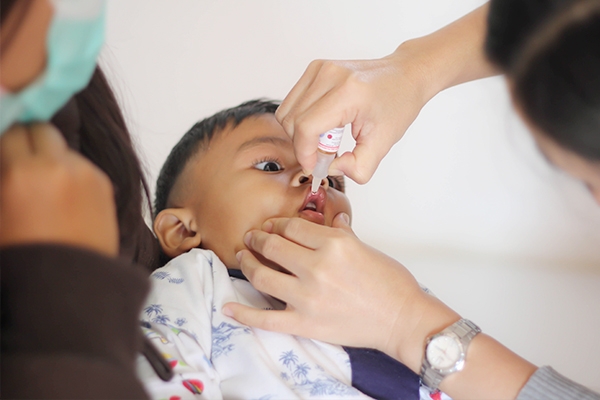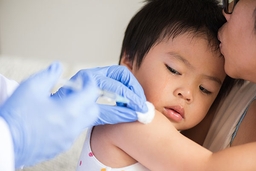Diseases Lurk! Let’s Vaccinate Our Children

Polio and measles are back! Apart from paralyzing many sectors, the COVID-19 pandemic has also reduced our awareness of the existence of these diseases. As a result, extraordinary incidents were identified in various regions.
"Rare" doesn’t mean "vanished"
According to Dr. Prima Yosephine, Director of Immunization Management at the Ministry of Health, there were over 3,341 reports of measles cases in 2022.
It is 32 times higher than in 2021. A measles outbreak was declared after two cases were confirmed in the laboratory and had epidemiological links.
In November 2022, a child from Pidie District, Aceh, tested positive for polio. When there is only one child infected with polio, the region is obliged to establish a polio outbreak. At the end of November, three children tested positive despite not having suffered from sudden wilting paralysis.
Measles, polio, rubella, hepatitis, diphtheria, tuberculosis, and pneumonia are among the many viral diseases that continue to plague humans. They do not go away because they are rare.
Why do we still need vaccines?

The nearly three-year COVID-19 pandemic has made us complacent. The slogan "stay at home" appears to support the postponement of complete childhood vaccinations. Furthermore, cases of measles and polio are rare. But it is not that simple.
We have an immune system, but it doesn't know which pathogens need to be destroyed until we introduce it to them. The faster the immune system recognizes and attacks pathogens, the easier it is to deal with the pathogen.
Vaccination is the most convenient, safest, and effective method of introducing pathogens into the immune system.
Vaccines contain viruses that have been weakened. The immune system will recognize it as a target to fight in the body. If a similar, stronger pathogen enters the body, the immune system immediately destroys it.
Aside from self-defense, another goal of vaccination is herd immunity. This is due to the fact that not everyone can be vaccinated. It could be the result of another health issue, such as cancer or HIV infection. They will be protected by the vaccinated person.
Vaccinations for children

Vaccines are designed and tested to be both safe and effective. Receiving age-appropriate vaccines will protect children from a wide range of deadly diseases. As adults, it is our responsibility to assist them in obtaining that protection.
The following is a list of mandatory vaccines for children aged 0 to 18 months.
- Hepatitis B. Prevent hepatitis B. The primary vaccine is administered at the age of six months. And then again, at 2 months, 3 months, and 4 months of age. Booster shots can be given as early as 18 months of age. Fever, redness at the injection site, nausea, and joint pain are all possible side effects.
- Polio. Prevent poliomyelitis, the leading cause of permanent paralysis. It is given at the ages of 0–1 month, 2 months, 3 months, and 4 months. Booster shots can be given at the age of 18 months. Post-vaccination side effects are uncommon.
- BCG. This prevents tuberculosis (TB). It must be given between the ages of 0 and 1 month. There are no repeats or boosters. Side effects are generally small boils at the injection site.
- DPT. It protects against diphtheria, pertussis, and tetanus. It is administered at the ages of two months, three months, and four months. Boosters can be administered at 18 months, 5–7 years, and 10–18 years (Td/Tdap vaccine). High fever, fussiness, and the appearance of redness, pain, and swelling at the injection site are all side effects of the vaccine.
- HiB. It prevents pneumonia, the leading cause of respiratory problems. It is given to children aged 2 months, 3 months, and 4 months. Booster shots are administered at the age of 18 months. Low-grade fever and redness, pain, and swelling at the injection site are common vaccine side effects.
- MR/MMR. The MR vaccine protects against measles and rubella. The MMR vaccine protects against mumps, measles, and rubella. It must be given at the age of 9 months.
Boosters are given at the ages of 18 months and 5–7 years. Mild fever, swollen glands behind the ear, and discomfort at the injection site are all common vaccine side effects.
The following is a list of additional vaccines that must be administered in order to maximize child development.
- PCV. It protects against pneumococcal infections, which cause infections of the ear, lung (pneumonia), blood, and brain (meningitis). The primary vaccine is administered at the ages of 2 months, 4 months, and 6 months. Boosters can be given to children aged 12–15 months. Fatigue, loss of appetite, fever or chills, headaches, and redness, swelling, and pain at the injection site are all common vaccine side effects.
- Rotavirus. It protects against viruses that cause diarrhea, fever, vomiting, and stomach pain. Primary vaccines are administered at the ages of 2 months, 4 months, and 6 months. The most common side effects are fussiness, diarrhea, and vomiting.
- Influenza. It protects against influenza virus infection. The primary vaccine is administered at the age of six months. Booster shots can be given once a year between the ages of 18 months and 18 years. Headache, fever, nausea, muscle aches, and redness, swelling, or pain at the injection site are all possible side effects.
- JE. It protects against Japanese Encephalitis, a disease spread by mosquito bites. The primary vaccine is administered at the age of 9 months. Booster shots can be given between the ages of 2 and 3 years. Headaches, muscle aches, and discomfort at the injection site are all possible side effects.
- Varicella. Prevent chickenpox. Given twice in the age range of 12–18 months, with a 6-week-3-month interval. A rash or blisters on the skin, headache, fever, and fatigue are all possible side effects.
- Hepatitis A. Prevents hepatitis A. It is administered twice in the age range of 12–24 months, with a 6-36-month interval in between. Some of the side effects include headache, fever, fatigue, and loss of appetite.
- Typhoid. It protects against typhoid infection. The primary vaccine is administered at the age of 24 months. In children aged 5–18, boosters can be repeated every three years. Fever, headache, and discomfort at the injection site are all possible side effects.
- HPV. Protect against papillomavirus infections of the skin and genitals. The primary vaccine is administered twice to children aged 9–14.
- Dengue. Control the spread of the virus that causes dengue fever. The primary vaccine is administered three times over a six-month period to children aged 9–16.
Vaccination is the most cost-effective way to achieve global prosperity. Vaccinations allow children to walk, run, play, dance, study, and pursue their dreams. Let’s guard them.



